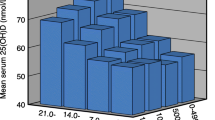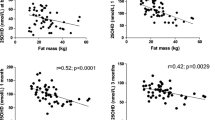Abstract
Purpose
This double-blind placebo-controlled trial evaluated serum 25-hydroxyvitamin D [25(OH)D] levels after the oral intake of a single dose of cholecalciferol during one of the three meals, containing different amounts of fat or placebo.
Methods and results
Sixty-four healthy medical residents or students of a university hospital in Porto Alegre, latitude 30°S, Brazil, were divided into four groups. Three groups received a single 50,000 IU oral dose of cholecalciferol during a meal containing 0 g (Group 1), 15 g (Group 2) or 30 g (Group 3) of fat, and one group received placebo (Group 4), according to randomization. Serum 25(OH)D, parathyroid hormone, total calcium, albumin, magnesium, and creatinine levels, and urinary calcium, magnesium, and creatinine levels were measured at baseline and after 14 days. Baseline mean serum 25(OH)D levels were low in all groups. Vitamin D given during breakfast increased the mean change of serum 25(OH)D levels, when compared to placebo. Furthermore, the intake of fat with vitamin D increased the mean change of serum 25(OH)D levels.
Conclusion
A single oral dose of vitamin D given with food increased mean serum 25(OH)D levels, after 2 weeks, and the mean increase was larger, when the meal had at least 15 g of fat. These findings can have important implications to oral vitamin D supplementation.


Similar content being viewed by others
References
Biancuzzo R, Young A, Bibuld D, Cai M, Winter M, Klein E, Ameri A, Reitz R, Salameh W, Chen T, Holick M (2010) Fortification of orange juice with vitamin D(2) or vitamin D(3) is as effective as an oral supplement in maintaining vitamin D status in adults. Am J Clin Nutr 91:1621–1626. doi:10.3945/ajcn.2009.27972
Dawson-Hughes B, Harris S, Palermo N, Ceglia L, Rasmussen H (2013) Meal conditions affect the absorption of supplemental vitamin D3 but not the plasma 25-hydroxyvitamin D response to supplementation. J Bone Miner Res 28:1778–1783. doi:10.1002/jbmr.1896
Heaney R, Recker R, Grote J, Horst R, Armas L (2011) Vitamin D(3) is more potent than vitamin D(2) in humans. J Clin Endocrinol Metab 96:E447–E452. doi:10.1210/jc.2010-2230
Holick MF (2007) Vitamin D deficiency. N Engl J Med 357:266–281
Holick MF, Binkley NC, Bischoff-Ferrari HA, Gordon CM, Hanley DA, Heaney RP, Murad MH, Weaver CM, Society E (2011) Evaluation, treatment, and prevention of vitamin D deficiency: an Endocrine Society clinical practice guideline. J Clin Endocrinol Metab 96:1911–1930. doi:10.1210/jc.2011-0385
Ilahi M, Armas L, Heaney R (2008) Pharmacokinetics of a single, large dose of cholecalciferol. Am J Clin Nutr 87:688–691
Iqbal J, Hussain MM (2009) Intestinal lipid absorption. Am J Physiol Endocrinol Metab 296:E1183–E1194 (Epub 2009 Jan 1121)
Johnson JL, Mistry VV, Vukovich MD, Hogie-Lorenzen T, Hollis BW, Specker BL (2005) Bioavailability of vitamin D from fortified process cheese and effects on vitamin D status in the elderly. J Dairy Sci 88:2295–2301
Kluczynski M, Wactawski-Wende J, Platek M, DeNysschen C, Hovey K, Millen A (2012) Changes in vitamin D supplement use and baseline plasma 25-hydroxyvitamin D concentration predict 5-y change in concentration in postmenopausal women. J Nutr 142:1705–1712
Mulligan GB, Licata A (2010) Taking vitamin D with the largest meal improves absorption and results in higher serum levels of 25-hydroxyvitamin D. J Bone Miner Res 25:928–930. doi:10.1002/jbmr.67
Nelson M, Blum J, Hollis B, Rosen C, Sullivan S (2009) Supplements of 20 microg/d cholecalciferol optimized serum 25-hydroxyvitamin D concentrations in 80 % of premenopausal women in winter. J Nutr 139:540–546. doi:10.3945/jn.108.096180
Niramitmahapanya S, Harris SS, Dawson-Hughes B (2011) Type of dietary fat is associated with the 25-hydroxyvitamin D3 increment in response to vitamin D supplementation. J Clin Endocrinol Metab 96:3170–3174. doi:10.1210/jc.2011-1518
Raimundo F, Faulhaber G, Menegatti P, Marques L, Furlanetto T (2011) Effect of high- versus low-fat meal on serum 25-hydroxyvitamin D levels after a single oral dose of vitamin D: a single-blind, parallel, randomized trail. Int J Endocrinol 2011:809069. doi:10.1155/2011/809069
Reboul E, Goncalves A, Comera C, Bott R, Nowicki M, Landrier JF, Jourdheuil-Rahmani D, Dufour C, Collet X, Borel P (2011) Vitamin D intestinal absorption is not a simple passive diffusion: evidences for involvement of cholesterol transporters. Mol Nutr Food Res 55:691–702. doi:10.1002/mnfr.201000553
Roberts WE (2009) Skin type classification systems old and new. Dermatol Clin 27:529–533, viii
Romagnoli E, Mascia M, Cipriani C, Fassino V, Mazzei F, D’Erasmo E, Carnevale V, Scillitani A, Minisola S (2008) Short and long-term variations in serum calciotropic hormones after a single very large dose of ergocalciferol (vitamin D2) or cholecalciferol (vitamin D3) in the elderly. J Clin Endocrinol Metab 93:3015–3020 (Epub 2008 May 3020)
Ryan JW, Anderson PH, Turner AG, Morris HA (2013) Vitamin D activities and metabolic bone disease. Clin Chim Acta 425:148–152. doi:10.1016/j.cca.2013.07.024
Saraiva GL, Cendoroglo MS, Ramos LR, Araujo LM, Vieira JG, Kunii I, Hayashi LF, Correa MP, Lazaretti-Castro M (2005) Influence of ultraviolet radiation on the production of 25 hydroxyvitamin D in the elderly population in the city of Sao Paulo (23 degrees 34′S), Brazil. Osteoporos Int 16:1649–1654 (Epub 2005 Jun 1610)
Schnabel P, Bagchus W, Lass H, Thomsen T, Geurts T (2007) The effect of food composition on serum testosterone levels after oral administration of Andriol Testocaps. Clin Endocrinol (Oxf) 66:579–585. doi:10.1111/j.1365-2265.2007.02781.x
Stechschulte SA, Kirsner RS, Federman DG (2009) Vitamin D: bone and beyond, rationale and recommendations for supplementation. Am J Med 122:793–802
Tangpricha V, Koutkia P, Rieke S, Chen T, Perez A, Holick MF (2003) Fortification of orange juice with vitamin D: a novel approach for enhancing vitamin D nutritional health. Am J Clin Nutr 77:1478–1483
Wagner D, Sidhom G, Whiting SJ, Rousseau D, Vieth R (2008) The bioavailability of vitamin D from fortified cheeses and supplements is equivalent in adults. J Nutr 138:1365–1371
Yin A, Alfadhli E, Htun M, Dudley R, Faulkner S, Hull L, Leung A, Bross R, Longstreth J, Swerdloff R, Wang C (2012) Dietary fat modulates the testosterone pharmacokinetics of a new self-emulsifying formulation of oral testosterone undecanoate in hypogonadal men. J Androl 33:1282–1290. doi:10.2164/jandrol.112.017020
Yoshida T, Stern PH (2012) How vitamin D works on bone. Endocrinol Metab Clin North Am 41:557–569. doi:10.1016/j.ecl.2012.04.003
Zhao L, Zhou Y, Bu F, Travers-Gustafson D, Ye A, Xu X, Hamm L, Gorsage D, Fang X, Deng H, Recker R, Lappe J (2012) Factors predicting vitamin D response variation in non-Hispanic white postmenopausal women. J Clin Endocrinol Metab 97:2699–2705. doi:10.1210/jc.2011-3401
Zittermann A, Ernst J, Gummert J, Börgermann J (2014) Vitamin D supplementation, body weight and human serum 25-hydroxyvitamin D response: a systematic review. Eur J Nutr 53:367–374
Acknowledgments
We are grateful to the Fundo de Incentivo à Pesquisa e Eventos of the Hospital de Clínicas de Porto Alegre, Porto Alegre, RS, Brazil, and the Conselho Nacional de Pesquisas of Brazil for funding our research and to Roberta Pires Bastos Oliveira for preparing vitamin D and placebo capsules. This work was supported by the Fundo de Incentivo à Pesquisa e Eventos, Hospital de Clínicas de Porto Alegre, Porto Alegre, RS, Brazil, and the Conselho Nacional de Pesquisas (CNPq), Brazil.
Conflict of interest
All authors state that they have no conflict of interests.
Author information
Authors and Affiliations
Corresponding author
Additional information
ClinicalTrials.gov: NCT01519986.
Rights and permissions
About this article
Cite this article
Raimundo, F.V., Lang, M.A.B., Scopel, L. et al. Effect of fat on serum 25-hydroxyvitamin D levels after a single oral dose of vitamin D in young healthy adults: a double-blind randomized placebo-controlled study. Eur J Nutr 54, 391–396 (2015). https://doi.org/10.1007/s00394-014-0718-8
Received:
Accepted:
Published:
Issue Date:
DOI: https://doi.org/10.1007/s00394-014-0718-8




